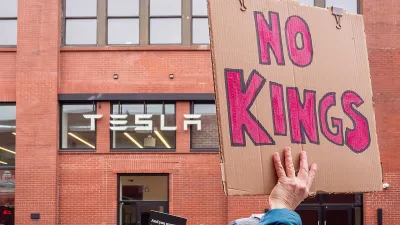At one time in the 1900s, a third of cars in major cities were powered by electric motors. Today, only about 1% of cars are fully electric. Why did we end up with gasoline-powered cars?
In the early 1900s, a series of unfortunate business events drove the country's largest electric vehicle carmaker -- called the Electric Vehicle Company -- into bankruptcy, and it devastated the electric car industry.
"Investors, soured by their experience with the E.V.C., swore they'd never put money into the industry again, and in the lull in electric-car development that followed, gasoline-car companies improved their technology and made their vehicles cheaper", writes Maggie Koerth-Baker of The New York Times. "Over the next 20 years, Americans formed a new idea of what a car was. And from that point on, right up to today, it was hard to get them to try anything else."
So will the US ever get back to electric cars? Koerth-Baker thinks it's possible to change both the infrastructure and culture that supports gasoline-powere cars: "The trick is to not expect people to jump straight from all-gasoline to all-electric. What's necessary is a transitional step that makes electric cars operate more like the cars we're used to driving... [and] hybrids will ultimately help us make that jump."
Thanks to Daniel Lippman
FULL STORY: Why Your Car Isn’t Electric

Alabama: Trump Terminates Settlements for Black Communities Harmed By Raw Sewage
Trump deemed the landmark civil rights agreement “illegal DEI and environmental justice policy.”

Planetizen Federal Action Tracker
A weekly monitor of how Trump’s orders and actions are impacting planners and planning in America.

Why Should We Subsidize Public Transportation?
Many public transit agencies face financial stress due to rising costs, declining fare revenue, and declining subsidies. Transit advocates must provide a strong business case for increasing public transit funding.

Understanding Road Diets
An explainer from Momentum highlights the advantages of reducing vehicle lanes in favor of more bike, transit, and pedestrian infrastructure.

New California Law Regulates Warehouse Pollution
A new law tightens building and emissions regulations for large distribution warehouses to mitigate air pollution and traffic in surrounding communities.

Phoenix Announces Opening Date for Light Rail Extension
The South Central extension will connect South Phoenix to downtown and other major hubs starting on June 7.
Urban Design for Planners 1: Software Tools
This six-course series explores essential urban design concepts using open source software and equips planners with the tools they need to participate fully in the urban design process.
Planning for Universal Design
Learn the tools for implementing Universal Design in planning regulations.
Caltrans
Smith Gee Studio
Institute for Housing and Urban Development Studies (IHS)
City of Grandview
Harvard GSD Executive Education
Toledo-Lucas County Plan Commissions
Salt Lake City
NYU Wagner Graduate School of Public Service




























